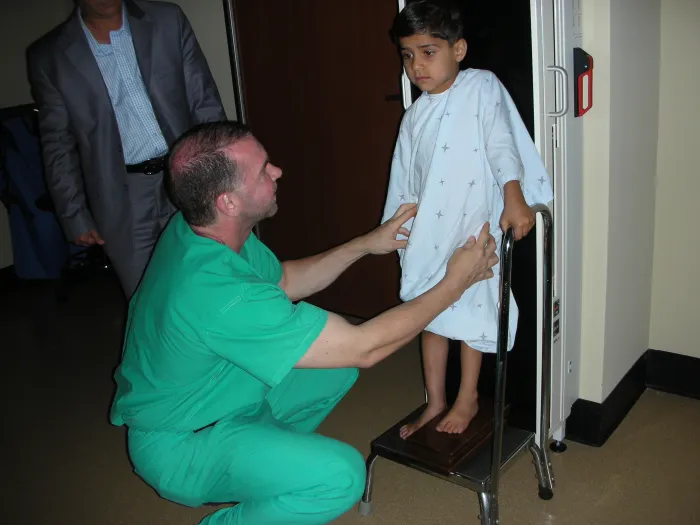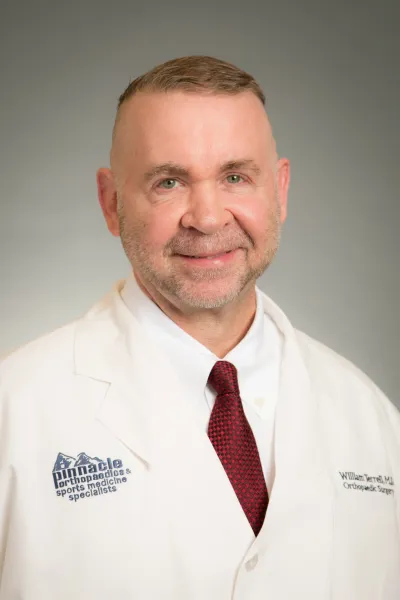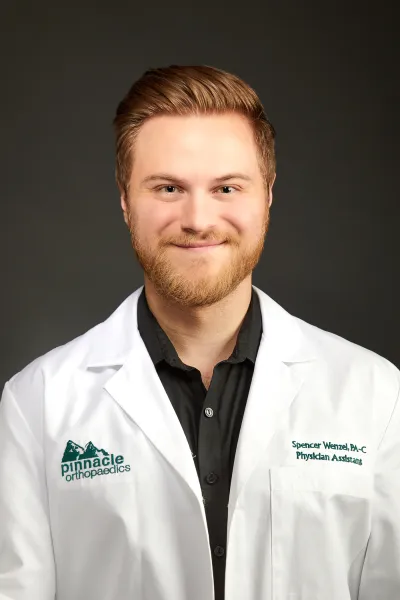
Limb Lengthening & Deformity Repair

Limb lengthening surgery is an inpatient procedure to lengthen the bones in the arms or legs. This is a gradual process that takes advantage of the body's ability to generate new bones.
The whole process may take several months to make sure that the bones slowly increase in length. Likewise, the soft tissues, blood vessels, nerves, and ligaments surrounding the bone should stretch slowly over time and support the lengthened bone.
Limb Lengthening and Deformity Repair is a very sophisticated orthopaedics sub-specialty that Dr. William Terrell offers at Pinnacle. He is one of the few limb lengthening and deformity correction specialists in the United States.
Who is eligible to undergo limb lengthening and deformity repair?
Patients are encouraged to have limb lengthening and deformity repair if they have bones with:
a considerable difference in limb length
severe fractures
non-unions
mal-unions
failed fixations
These conditions can be a result of either trauma or a defect and vary in severity. This orthopaedic specialty also involves a broad range of treatments of bones that won't heal, have formed or healed incorrectly, or have become infected. This includes cases with patients who have had multiple procedures, such as bone grafts, that have not healed properly.
What to expect before, during, and after limb lengthening surgery in Marietta and Woodstock?
To prepare for the procedure, you will be given detailed instructions and reminders about what you can and cannot do before the surgery.
Generally, patients are advised to remain physically active, eat healthy meals, and stop smoking to ensure a good recovery.
Your doctor will also document all the medications and supplements you are taking. If one of them has a chance of reacting with anesthesia or increasing your risk of bleeding, you might be advised to stop taking it in the days leading up to the surgery. The doctor may also run laboratory and imaging tests.
Before the surgery
On the day of your surgery, you will be given pre-operative care. You will need to change into a hospital gown, undergo a brief physical examination, and answer questions from the surgical team. If there is anything that bothers you or if you want to clarify some information, you are free to ask. After which, you will be hooked to an IV for delivering medicines and fluids.
You will now be wheeled to the operating room, where the surgical team will sterilize the skin where the incisions will be made.
During the surgery
During the entire operation, you may either be under general anesthesia, which puts you to sleep, or epidural anesthesia, which numbs you from the waist down.
General anesthesia is given either through an IV line or inhaled through a breathing mask, while epidural anesthesia is injected into the epidural space in the lower back. Unlike general anesthesia, patients under epidural anesthesia remain awake during the surgery.
In the first part of the surgery, the bone that is to be lengthened is cut into two separate segments. The second part includes the placement of fixation devices (internal, external, or both) and the insertion of the lengthening device.
Osteotomy or bone cutting
Osteotomy is a surgical procedure that entails cutting the bone to create two bone segments. The surgeon may also need to perform additional surgical strategies to correct deformities or misalignment. Then, an orthopaedic lengthening device will be applied.
Lengthening device insertion
There are two types of lengthening devices:
External fixator
An external fixator can be adjusted from the outside. It has a metal frame outside the limb that is connected to the bone using pins, screws, and wires.
Internal devices
Internal devices can come in the form of a motorized nail or rod. These are inserted into the bone marrow cavity of the target limb. They can be adjusted using a remote control device that rotates a magnet in the nail or rod to increase its length.
The lengthening device will need to remain attached for a few months until the bone is fully healed. Then, it can be safely removed in a surgical outpatient procedure.
After the surgery
After the operation, you will be transferred to the recovery room and observed for a few hours. Then, you will be wheeled to your room, where you will stay for 2-3 days.
If you underwent a leg lengthening surgery, you will be given instructions on how to get in and out of bed, use assistive devices such as crutches or a walker, climb stairs, and transfer from a chair to the toilet seat. You will not be allowed to bear weight on the operated leg.
Latency period
This is the period after the surgery and before the leg lengthening process. During the latency period, patients are advised to rest for a week. Resting the operated area prepares the bone for the healing or recovery process, which comes in two phases: distraction and consolidation.
What are the potential risks involved?
Limb lengthening has very minimal scarring and a 95% success rate. This procedure is safe and has very promising potential. However, just like any surgery, it has a number of risks such as:
Nerve damage
Damage to surrounding tissues
Osteomyelitis or bone infection
Poor bone healing
Restricted bone growth
If you want to have limb lengthening surgery, talk to Dr. William Terrel, our expert orthopaedic surgeon. Based on your medical history, he will discuss the treatment plan, benefits, and possible surgical risks to find out if limb lengthening is a good option for you.
What to expect during the recovery process?
After undergoing limb lengthening in Woodstock or Marietta, you will go through two phases of recovery.
Distraction phase
In this phase, the orthopaedic surgeon will gradually pull apart the two bone segments. This promotes the growth of new bones (called regenerate bones) at the site where they were cut.
To ensure continuous bone growth, the gap between the two bone segments will be increased 4 times a day. Each adjustment will increase the gap by 0.25 millimeters so that each day, the bone will be distracted for a total of 1 millimeter. This may slightly differ, depending on the target bone. The body will continue to produce new bone tissue to fill the growing space between the bone segments until the desired bone length is achieved.
The patient may need to visit his orthopaedic doctor for follow-ups to make sure that the bone is lengthening at a safe and recommended pace. This can be determined based on how the new bone appears on an X-ray. Depending on the assessment, the doctor may increase or decrease the rate of distraction.
Consolidation phase
In the consolidation phase, the new bone slowly hardens and solidifies. A target length of 5 centimeters requires about 2 months of distraction and 3 more months of bone hardening. Therefore, the lengthening device will need to stay in place for 5 months. It will not be removed until the new bone has fully healed, hardened, and calcified.
During this phase, patients who underwent leg lengthening would still need to use crutches or a walker. They will now be advised to start putting weight on the arm or leg to stimulate bone healing and hardening.
Once the new bone has fully healed, the surgeon will now remove the orthopaedic lengthening device.
After removing an external fixator, the patient will still need to wear a cast or a brace for a month to add protection and stability to the new bone. On the other hand, if an internal device was used and removed, there's no need to apply a cast.
You will also be advised to undergo physical therapy to improve range of motion, limb strength, and limb mobility as the bone heals.
What is deformity repair?
Deformity repair is performed on bones that are out of alignment, bent, or twisted. The goal of surgery is to straighten the limb to achieve normal function.
There are two ways to repair a deformity. Your orthopedic surgeon will decide which of these two approaches is best for your condition.
Acute correction
In an acute repair or correction, all the necessary procedures are done in a single surgery. The first step is called osteotomy, wherein the target bone will be cut into two separate segments. Next, the orthopedic surgeon will correct the position of the bone.
The third step includes the insertion of an internal device, such as an internal rod or a metal plate, to keep the bone in its proper position while it heals. Once the bone is completely healed, the internal device will be removed.
Gradual correction
In a gradual repair, the corrections are performed over several weeks or months. Before osteotomy, the surgeon will first apply an external fixator to the bone to keep it in its position.
Distraction Phase. After the surgery, the doctor will instruct the patient on how to adjust the external fixators to separate and align the bone segments. New bones will form in the space between them.
Just like in limb lengthening, the patient also needs to attend physical therapy sessions and avoid putting weight on the limb.
Consolidation Phase. This stage is longer than the distraction phase, wherein the new bone gradually hardens and solidifies. The external fixator remains attached to the bone to keep it in position.
During the healing phase, patients are encouraged to increase their intake of protein, vitamins, and minerals and avoid any form of nicotine. With the help of a physical therapist, they may now start to put some weight on the limb to facilitate bone healing. The external fixator will be removed once the bone has fully healed and solidified.
Answers to common questions about limb lengthening surgery:
Is the procedure painful?
You will be under anesthesia during the surgery, so you will not feel any pain. During the lengthening process, you may experience some soreness in the operated limb. Your doctor can give you pain relievers to reduce the pain and discomfort.
How much can the bone be lengthened?
Typically, the bone can be lengthened by 2 inches per treatment. However, this largely depends on your specific circumstances. Your orthopaedic surgeon will determine the amount of lengthening that can be safely done to your limb.
Can I use my limb during treatment?
During the distraction phase, you can use assistive devices like a walker or crutches to move around, but you are not allowed to bear weight on the operated leg.
During the consolidation phase, you will now be encouraged to gradually put weight on the operated leg. Depending on your pain tolerance and leg strength, you may slowly begin to walk without the help of mobility aids.
How long will the lengthening take?
The amount of time largely depends on how much the limb needs to grow. Lengthening usually takes 1 mm per day.
It is crucial to adhere to recommended adjustments because:
If the lengthening is too slow, the new bone may harden prematurely even before the treatment is complete.
If the lengthening is too fast, there might not be enough time for new bones to form.
Generally, patients take 6-9 months from the time of surgery to full recovery. This timeframe may vary, depending on your overall health condition and adherence to treatment.
When can I return to normal activities?
You can return to your normal activities as soon as the bone has healed completely and your range of motion and muscle strength have returned to normal with the help of physical therapy.
How can I ensure that the lengthened limb will function well?
It is important to follow the doctor's advice. Physical therapy and exercise are also essential to ensure that the bones, soft tissues, nerves, muscles, and ligaments have maintained their function.
Teamwork is a crucial determinant to a successful limb lengthening surgery and deformity repair. This includes the skills and experience of the orthopaedic surgeon, the expertise of the physical therapist, the moral support of loved ones, and the commitment of the patient to the treatment regimen.
What foods should I avoid?
While the new bone is healing, patients should not take nicotine in any form. Nicotine can interfere with healing, as it slows the production of bone-forming cells and affects the body's ability to absorb calcium.
Patients should also eat a healthy and protein-rich diet. Protein has a positive effect on bone mineral density and can help produce stronger bones. Your doctor may also prescribe you with vitamins and mineral supplements.
Where to find the best limb lengthening orthopaedic surgeon near me?
If you are looking for an orthopedic surgeon specializing in deformity correction and limb lengthening in Georgia, Dr. William Dean Terrell is considered to be one of the very best. He is one of our esteemed doctors at Pinnacle Orthopaedics in Marietta and Woodstock.
Dr. Terrel has treated thousands of patients of all ages to correct their complex bone deformities and/or their musculoskeletal disorders. He is also Board Certified with Fellowships in Sports Medicine and AO Trauma and has extensive training in the Ilizarov Technique.
Where to find the nearest Pinnacle Orthopaedics near me?
Pinnacle orthopaedics has been offering the best treatment and patient care available in our community for 50 years. We utilize the most up-to-date technologies and surgical techniques to provide our patients with the highest quality of care.
Our physicians and staff provide exceptional orthopedic care at five convenient locations in the area:
If you have questions or are ready for a consultation, please reach out or make an inquiry on our contact page. We look forward to working with you!
The material contained on this site is for informational purposes only and DOES NOT CONSTITUTE THE PROVIDING OF MEDICAL ADVICE, and is not intended to be a substitute for independent professional medical judgment, advice, diagnosis, or treatment. Always seek the advice of your physician or other qualified healthcare providers with any questions or concerns you may have regarding your health.

